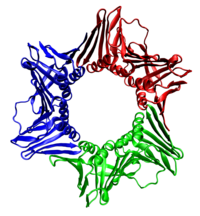
Photo from wikipedia
There is extensive literature on PARP1, owing to the multiple functions of PARP1 for DNA repair, aging, chromatin remodeling and transcription, and to the successful clinical development of four PARP… Click to show full abstract
There is extensive literature on PARP1, owing to the multiple functions of PARP1 for DNA repair, aging, chromatin remodeling and transcription, and to the successful clinical development of four PARP inhibitors. In this issue of Cancer Research, Wang and colleagues identified phosphatase 1 nuclear targeting subunit (PNUTS, also referred to as PP1R10) as a partner of PARP1 and demonstrated that PNUTS and PARP1 are interdependent for their recruitment to DNA damage sites. As PARP1 is a prominent target for cancer therapy and PNUTS has PARP-dependent as well as PARP1-independent activities, the findings of Wang and colleagues add insight into DNA repair mechanisms with potential application to drug targeting and precision therapy.See related article by Wang et al., p. 2526.
Journal Title: Cancer research
Year Published: 2019
Link to full text (if available)
Share on Social Media: Sign Up to like & get
recommendations!